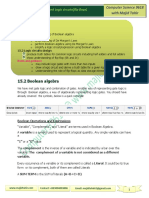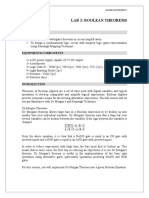DLD 2
DLD 2
Uploaded by
tixel62099Copyright:
Available Formats
DLD 2
DLD 2
Uploaded by
tixel62099Original Title
Copyright
Available Formats
Share this document
Did you find this document useful?
Is this content inappropriate?
Copyright:
Available Formats
DLD 2
DLD 2
Uploaded by
tixel62099Copyright:
Available Formats
Name: Instructor: Engr.
Date Performed: Marks Obtained: /10
Group Members
(ID):…………………………………………………………………………………….
Checked By:____________________ Date:___________
Experiment # 02
De-Morgan's Laws
OBJECTIVES:
To Verify De-Morgan's laws
Required Components and Equipment:
IC numbers 7400, 7402, 7404, 7408,7432
Digital electronics trainer.
Connecting Wires
De-Morgan's Laws
Boolean algebra has postulates and identities. We can often use these laws to reduce
expressions or put expressions in to a more desirable form. One of these laws is the De-
Morgan's law.
De-Morgan's law has two conditions, or conversely, there are two laws called De-Morgan's
Laws.
First Condition or First law:
The compliment of the product of two variables is equal to the sum of the compliment of each
variable.
Thus according to De-Morgan's laws or De-Morgan's theorem if A and B are the two variables
or Boolean numbers. Then accordingly
̅̅̅̅) = 𝑨
(𝑨𝑩 ̅+𝑩
̅
This means that NAND gate function is identical to OR gate function with complemented
inputs.
Digital Logic Design (EE222) Air University, Islamabad
Second Condition or Second law:
The compliment of the sum of two variables is equal to the product of the compliment of each
variable.
Thus according to De Morgan’s theorem if A and B are the two variables then.
̅̅̅̅̅̅̅̅
(𝑨 ̅. 𝑩
+ 𝑩) = 𝑨 ̅
This means that NOR function is equal to the AND gate function with complemented inputs.
Logic Diagram:
First Condition:
Left Hand Side:
Right Hand Side:
Digital Logic Design (EE222) Air University, Islamabad
Second Condition:
Left Hand Side:
Right Hand Side:
PROCEDURE:
1. Patch the left hand side circuit for the first condition of De-Morgan's Law on the Digital
electronics trainer. Connect the inputs to the input switches and output to the LED and
verify the truth table for all the combinations
2. Similarly, patch the right hand side circuit for the first condition of De-Morgan's Law
on the Digital electronics trainer. Connect the inputs to the input switches and output to
the LED and verify the truth table for all the combinations. Both the truth tables should
be similar.
3. Repeat steps 1 and 2 for the second condition of De-Morgan's Law.
4. Get it checked by the instructor.
Truth table for the first condition:
A B ̅̅̅̅)
𝐘 = (𝐀𝐁 ̅+𝑩
𝒀=𝑨 ̅
0 0
0 1
1 0
1 1
Truth table For the second condition:
A B ̅̅̅̅̅̅̅̅
𝒀 = (𝑨 + 𝑩) ̅. 𝑩
𝒀=𝑨 ̅
0 0
0 1
1 0
1 1
Digital Logic Design (EE222) Air University, Islamabad
Student Exercise:
1. Implement De-Morgan's law on Proteus.
2. Verify De-Morgan's Law for 3 inputs.
3. Suppose you needed an inverter gate in a logic circuit, but none were available. You do
however, have a spare (unused) NOR gate in one of the integrated circuits. Show how
you would connect a NOR gate to function as an inverter.
4. Write the Boolean expression for this logic gate circuit
Note: Write a short report on this experiment in your own words.
……………………………………………………………………………………
……………………………………………………………………………………
……………………………………………………………………………………
……………………………………………………………………………………
……………………………………………………………………………………
……………………………………………………………………………………
……………………………………………………………………………………
……………………………………………………………………………………
……………………………………………………………………………………
……………………………………………………………………………………
……………………………………………………………………………………
……………………………………………………………………………………
……………………………………………………………………………………
………………………………
Good Luck
Digital Logic Design (EE222) Air University, Islamabad
You might also like
- RIPS C869 Manual Service PDFDocument791 pagesRIPS C869 Manual Service PDFcatalinni50% (8)
- Energy Losses in Bends and Fittings Lab ReportDocument7 pagesEnergy Losses in Bends and Fittings Lab ReportHannan AyubNo ratings yet
- CDR (Competency Demonstration Report) Writing Services India Hyderabad - Migration Skills Assessment Engineers AustraliaDocument2 pagesCDR (Competency Demonstration Report) Writing Services India Hyderabad - Migration Skills Assessment Engineers AustraliaprofessionalwritersNo ratings yet
- de Morgans TheoremDocument5 pagesde Morgans TheoremAsad Ullah0% (1)
- DLD Lab Report 2Document9 pagesDLD Lab Report 2Umair WaqasNo ratings yet
- Lab#2 (DeMorgan's Law)Document5 pagesLab#2 (DeMorgan's Law)Hammad Iftikhar Hanif100% (1)
- DLD Lab 2Document7 pagesDLD Lab 2KING BotNo ratings yet
- Lab 2Document5 pagesLab 2abuzarkazmi779No ratings yet
- Digital Logic Design Lab Report 02Document6 pagesDigital Logic Design Lab Report 02Anus BabarNo ratings yet
- DLD Lab Manual 04Document2 pagesDLD Lab Manual 04Sana gullNo ratings yet
- Implementation of de Morgan's Law With Two Input.Document3 pagesImplementation of de Morgan's Law With Two Input.Mohayminul Al-HamimNo ratings yet
- DEC Manual-2017Document52 pagesDEC Manual-2017Gopalakrishna Murthy C RNo ratings yet
- Assignment MathematicsDocument50 pagesAssignment MathematicsAravinda A KumarNo ratings yet
- De MorganDocument3 pagesDe Morgantanvirmohammed1951No ratings yet
- Section TwoDocument14 pagesSection Twogilbertkudi7No ratings yet
- De Morgans LawDocument5 pagesDe Morgans LawJaber Al NahianNo ratings yet
- Boolean Theorems Experiment 4Document7 pagesBoolean Theorems Experiment 4Tom Lindley VillarealNo ratings yet
- 21CS33Document30 pages21CS33Shanthi.VNo ratings yet
- Computer Organization Unit 2Document23 pagesComputer Organization Unit 2ascentrdgargNo ratings yet
- Digital Logic2Document16 pagesDigital Logic2prajwol neupaneNo ratings yet
- De Morgans TheoremDocument3 pagesDe Morgans Theoremmdrabbigazi2000No ratings yet
- Logic Gates & Boolean Algebra-1Document28 pagesLogic Gates & Boolean Algebra-1sandhiya SanNo ratings yet
- Omartarekamer CorrectedDocument22 pagesOmartarekamer CorrectedOmar AmerNo ratings yet
- Assignment Mathematics (1) .OdpDocument30 pagesAssignment Mathematics (1) .OdpAravinda A KumarNo ratings yet
- 15.2 Logic Circuits, Boolean Algebra, FlipFlopDocument11 pages15.2 Logic Circuits, Boolean Algebra, FlipFlopkimNo ratings yet
- Fundamentals of LogicDocument56 pagesFundamentals of LogicFrancis Gutierrez BalazonNo ratings yet
- U17EC017 Lab5Document9 pagesU17EC017 Lab5rosestrikesNo ratings yet
- Chapter 4: Digital Logic Circuits: ObjectivesDocument8 pagesChapter 4: Digital Logic Circuits: ObjectivesSteffany RoqueNo ratings yet
- DLD Lab # 02 Part 2Document6 pagesDLD Lab # 02 Part 2sabahatfatimaNo ratings yet
- Digit1 Lab02Document10 pagesDigit1 Lab02priyadarshini212007No ratings yet
- Xperiment O. 3: Digital Logic Design Laboratory Hand BookDocument9 pagesXperiment O. 3: Digital Logic Design Laboratory Hand BookM. Ahmad RazaNo ratings yet
- MT3812 LoLeakage Test Result 1.0Document10 pagesMT3812 LoLeakage Test Result 1.0Shailesh YadavNo ratings yet
- Lab:03 Analysis of Electro/mechanical Systems in Frequency DomainDocument4 pagesLab:03 Analysis of Electro/mechanical Systems in Frequency DomainHashim GurmaniNo ratings yet
- Note Binary B - Sequences: A New Upper Bound: 2001 Academic PressDocument4 pagesNote Binary B - Sequences: A New Upper Bound: 2001 Academic PressjohnoftheroadNo ratings yet
- DLD Exp 6 Student Manual PDFDocument4 pagesDLD Exp 6 Student Manual PDFS M AkashNo ratings yet
- HDL Manual 2020 5th Sem E&CE 18ECL58Document74 pagesHDL Manual 2020 5th Sem E&CE 18ECL58vishvakiranaNo ratings yet
- DeterminantsDocument4 pagesDeterminantsManoj KhandelwalNo ratings yet
- Argonne National Laboratory 9700 South Cass Avenue Argonne, Illinois 60439Document57 pagesArgonne National Laboratory 9700 South Cass Avenue Argonne, Illinois 60439putririzkiahNo ratings yet
- Lab7 Honors PDFDocument19 pagesLab7 Honors PDFPrasanth VarasalaNo ratings yet
- Lab 1 RC CircuitsDocument12 pagesLab 1 RC CircuitsReyson pearsNo ratings yet
- !ST Course Digital System Lectures 2010-2011 PDFDocument59 pages!ST Course Digital System Lectures 2010-2011 PDFkecodon123100% (1)
- Unit 1Document25 pagesUnit 1ahil12345678901No ratings yet
- Practical: 09 To Realize The Magnitude ComparatorDocument4 pagesPractical: 09 To Realize The Magnitude ComparatorSohil VohraNo ratings yet
- DSDLAB 18ECL38-2021Document101 pagesDSDLAB 18ECL38-2021ra23eceNo ratings yet
- Lab Report Encoders and DecodersDocument10 pagesLab Report Encoders and DecodersOwais FarooqNo ratings yet
- Chapter 12 Bode PlotsDocument39 pagesChapter 12 Bode PlotsMayar Magdy MorkosNo ratings yet
- Lab Experiment # 9: Implementation and Verification of Truth Table of 8x3 EncoderDocument3 pagesLab Experiment # 9: Implementation and Verification of Truth Table of 8x3 EncoderSaad khanNo ratings yet
- AL ICT m3 Logic FirstDocument5 pagesAL ICT m3 Logic FirstKanishka SeneviratneNo ratings yet
- Pe Lab 5NDocument8 pagesPe Lab 5Nsaharghafoor45No ratings yet
- Experiment3 HAMZADocument14 pagesExperiment3 HAMZAhamzasamara80No ratings yet
- Lab 14Document11 pagesLab 14amalkatribNo ratings yet
- 1 Digital Techniques - OcrDocument69 pages1 Digital Techniques - OcrAbhilekh SinghNo ratings yet
- BIT DL 2Document17 pagesBIT DL 2Aniket KhargaNo ratings yet
- C. Byregowda Institute of Technology: HDL Lab ManualDocument67 pagesC. Byregowda Institute of Technology: HDL Lab ManualDineshNo ratings yet
- Mangonel Lecture 1Document36 pagesMangonel Lecture 1divyanshuNo ratings yet
- ISRO Scientist Electrical 2020 EnglishDocument19 pagesISRO Scientist Electrical 2020 Englishshivabadugu2k100% (1)
- BEEE Experiment-8Document2 pagesBEEE Experiment-8Khushee SinghNo ratings yet
- 4 Demorgan LawDocument3 pages4 Demorgan LawSohil VohraNo ratings yet
- Lab 1 Digital Logic Gates and Boolean FunctionsDocument7 pagesLab 1 Digital Logic Gates and Boolean FunctionsIfthakharul Alam Shuvo100% (1)
- Learn Digital and Microprocessor Techniques on Your SmartphoneFrom EverandLearn Digital and Microprocessor Techniques on Your SmartphoneNo ratings yet
- Digital and Microprocessor Techniques V11From EverandDigital and Microprocessor Techniques V11Rating: 4.5 out of 5 stars4.5/5 (2)
- Analog Dialogue, Volume 48, Number 1: Analog Dialogue, #13From EverandAnalog Dialogue, Volume 48, Number 1: Analog Dialogue, #13Rating: 4 out of 5 stars4/5 (1)
- Design of Electrical Circuits using Engineering Software ToolsFrom EverandDesign of Electrical Circuits using Engineering Software ToolsNo ratings yet
- 150512-150704-Object Oriented Programming With JavaDocument1 page150512-150704-Object Oriented Programming With JavaAlpa Dalal SandesaraNo ratings yet
- 2buan (Bom)Document26 pages2buan (Bom)Roberto Jr ParagasNo ratings yet
- Interchangeability in SAPDocument40 pagesInterchangeability in SAPsumitjain_25100% (2)
- Flixo Manual PDFDocument331 pagesFlixo Manual PDFhisambergNo ratings yet
- Bajaj Finserv (2nd Visit) Recruitment Drive-Interview On 17th Sept'2022 For 2023 Graduating BatchDocument4 pagesBajaj Finserv (2nd Visit) Recruitment Drive-Interview On 17th Sept'2022 For 2023 Graduating BatchAbhishek MohantyNo ratings yet
- 01 - Quick Installation Guide (Windows)Document32 pages01 - Quick Installation Guide (Windows)Sri Atman jiNo ratings yet
- Chapter 12eng Computer System OverviewDocument25 pagesChapter 12eng Computer System OverviewEditorial BranchNo ratings yet
- Express Animate Help PDFDocument63 pagesExpress Animate Help PDFwestan11100% (1)
- 2021 (July) Practical Training Rating SheetDocument1 page2021 (July) Practical Training Rating SheetRitik agarwal100% (2)
- TPM 1 Naskah Komplain Pelanggan-AFROHUL MILAH 2Document2 pagesTPM 1 Naskah Komplain Pelanggan-AFROHUL MILAH 2Afrohul MilahNo ratings yet
- Specification Sheet - SM15 - ENDocument2 pagesSpecification Sheet - SM15 - ENasdadNo ratings yet
- Colocviu EnglezaDocument2 pagesColocviu EnglezaLivia Liv100% (1)
- Overview of AuditingDocument19 pagesOverview of AuditingPrecious FlorendoNo ratings yet
- Kyoto Design Lab. The Tangible and The Intangible of The Machiya HouseDocument64 pagesKyoto Design Lab. The Tangible and The Intangible of The Machiya HouseSIA chananNo ratings yet
- AVK Air Release ValvesDocument12 pagesAVK Air Release ValvesAr JunNo ratings yet
- SDM ReportDocument44 pagesSDM ReportSHANKAR PRINTINGNo ratings yet
- Yww7Pogiq - Understanding API 6a Gate ValvesDocument1 pageYww7Pogiq - Understanding API 6a Gate ValvesRuilin TanNo ratings yet
- Technical Data: NCB8-18GM40-N0-V1Document3 pagesTechnical Data: NCB8-18GM40-N0-V1Juan Pablo MarvalNo ratings yet
- Posting General Journal Entries (J58)Document6 pagesPosting General Journal Entries (J58)waqar anwarNo ratings yet
- 2014 Presentation On Stainless StructuralsDocument72 pages2014 Presentation On Stainless StructuralsWhite_rabbit2885764No ratings yet
- FLO 11-01-002 C001 Valdisk 61508 Certificate Oct 2014Document2 pagesFLO 11-01-002 C001 Valdisk 61508 Certificate Oct 2014anon_391099105No ratings yet
- Comparison Test Pump: User End DetailsDocument2 pagesComparison Test Pump: User End DetailsPradeepNo ratings yet
- Advertising Strategy - DaewooDocument16 pagesAdvertising Strategy - DaewooManish SharmaNo ratings yet
- Vlsi Design Basics - OdpDocument26 pagesVlsi Design Basics - OdpganapathiNo ratings yet
- JIST All Sem Syllabus Etc PDFDocument5 pagesJIST All Sem Syllabus Etc PDFddipyenduNo ratings yet
- Kiyora Catlog SeiresDocument6 pagesKiyora Catlog SeiresMd SazadNo ratings yet
- Members Data 8Document2 pagesMembers Data 8jaime huertasNo ratings yet

























































































